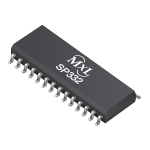
Overview
| Information | RS-232/RS-485 Multi-Mode Serial Transceiver |
|---|---|
| Supported Protocols | RS232, V.28, RS485, RS422, V.24 |
| Supply Voltage (Nom) (V) | 5 |
| 232 Tx / Rx | 4 / 4 |
| 485 Tx / Rx | 2 / 2 |
| RS-232 Max Data Rate (Mbps) | 0.12 |
| RS-485/RS-422 Max Data Rate (Mbps) | 10 |
| HBM ESD (kV) | 2 |
| IEC 61000-4-2 Contact (±kV) | - |
| 120Ω Termination | |
| VL Pin | |
| 232 Full Handshake | |
| Slew Limit Pin | |
| Fault Tolerance (V) | |
| RS-485 Duplex | Full |
| Max ICC (mA) | 120 |
| Temperature Range (°C) | 0 to 70, -40 to 85 |
| Package | SOIC-28 |
The SP332 is a monolithic device that contains both RS-232 and RS-485 line drivers and receivers. The configuration of the SP332 can be changed at any time by changing the logic state of two control input pins. The device also includes a loop back function which internally connects driver outputs to receiver inputs for a chip self test. A Sipex-patented charge pump (5,306,954) allows +5V-only operation.
- +5V-Only Single Supply Operation
- 4 Drivers, 4 Receivers RS-232
- 2 Drivers, 2 Receivers RS-485
- Loop Back Function for Self Test
- 28 Pin SOIC Packaging
Documentation & Design Tools
| Type | Title | Version | Date | File Size |
|---|---|---|---|---|
| Data Sheets | RS-232/RS-485 Multi-Mode Serial Transceiver | 1.0.1 | October 2017 | 484.7 KB |
| Application Notes | Advantages of Designing with Multi-Protocol Transceivers Application Note | R00 | September 2023 | 2.5 MB |
| Application Notes | DAN-190, MaxLinear UARTs in RS-485 Applications | R01 | July 2023 | 2.4 MB |
| Application Notes | RS-232 and RS-485 PCB Layout Application Note | R00 | December 2022 | 2.8 MB |
| Application Notes | ANI-16, Design Guide for Multi-Protocol Serial Ports | A | November 2005 | 462.9 KB |
| User Guides & Manuals | XR21B1420 Evaluation Board User’s Manual | 1B | January 2020 | 1.2 MB |
| Product Brochures | Interface Brochure | R01 | June 2024 | 3.6 MB |
| Product FAQs | SP332 FAQ | 1.0.0 | July 2007 | 211.2 KB |
| Schematics & Design Files | XR21B1420/1421 Evaluation Board Design Files | REV 10 | June 2016 | 386.5 KB |
Quality & RoHS
| Part Number | RoHS | Exempt | RoHS | Halogen Free | REACH | TSCA | MSL Rating / Peak Reflow | Package |
|---|---|---|---|---|---|---|---|
| SP332CT-L | N | Y | Y | Y | Y | L3 / 260ᵒC | WSOIC28 |
| SP332ET-L | N | Y | Y | Y | Y | L3 / 260ᵒC | WSOIC28 |
Click on the links above to download the Certificate of Non-Use of Hazardous Substances.
Parts & Purchasing
| Part Number | Pkg Code | Min Temp | Max Temp | Status | Suggested Replacement | Buy Now | Order Samples | PDN |
|---|---|---|---|---|---|---|---|---|
| SP332CT | WSOIC28 | 0 | 70 | OBS | ||||
| SP332CT-L | WSOIC28 | 0 | 70 | Active | Order | |||
| SP332CT-L/TR | WSOIC28 | 0 | 70 | OBS | SP336EEY-L/TR | |||
| SP332CT/TR | WSOIC28 | 0 | 70 | OBS | ||||
| SP332ET | WSOIC28 | -40 | 85 | OBS | ||||
| SP332ET-L | WSOIC28 | -40 | 85 | Active | Order | |||
| SP332ET-L/TR | WSOIC28 | -40 | 85 | OBS | SP332ET-L | |||
| SP332ET/TR | WSOIC28 | -40 | 85 | OBS | ||||
| XR21B1420IL28-0A-EVB | Board | Active |
Active - the part is released for sale, standard product.
EOL (End of Life) - the part is no longer being manufactured, there may or may not be inventory still in stock.
CF (Contact Factory) - the part is still active but customers should check with the factory for availability. Longer lead-times may apply.
PRE (Pre-introduction) - the part has not been introduced or the part number is an early version available for sample only.
OBS (Obsolete) - the part is no longer being manufactured and may not be ordered.
NRND (Not Recommended for New Designs) - the part is not recommended for new designs.
Packaging
| Pkg Code | Details | Quantities | Dimensions |
|---|---|---|---|
| WSOIC28 |
|
|
|
Notifications
FAQs & Support
Search our list of FAQs for answers to common technical questions.
For material content, environmental, quality and reliability questions review the Quality tab or visit our Quality page.
For ordering information and general customer service visit our Contact Us page.
Submit a Technical Support Question As a New Question
For RS-232 it is 50 feet (15 meters), or the cable length equal to a capacitance of 2500 pF, at a maximum transmission rate of 19.2kbps. When we reduce the baud rate, it allows for longer cable length. For Example:
| Baud Rate (bps) | Maximum RS-232 Cable Length (ft) |
| 19200 | 50 |
| 9600 | 500 |
| 4800 | 1000 |
| 2400 | 3000 |

The Parts & Purchasing section of the product page shows the Status of all orderable part numbers for that product. Click Show obsolete parts, to see all EOL or OBS products.

Videos
How to Design a Multiprotocol System using Only 1 Connector
Industrial networks support multiple serial interfaces such as RS-485 and RS-232. Using a multiprotocol transceiver enables industrial equipment to support both protocols using only one connector. Enabling both smaller and lower cost equipment designs. This video describes how to design multiprotocol systems using only one connector.
